|
Since World War II, the swastika symbol has been strongly associated with the Nazi party and their ideals, at least on the western side of the world. But the Nazis were not the creators of the swastika, nor original in their adaptation of it. The swastika has been around for at least 11,000 years . Historically, it has most commonly been used as a sacred religious symbol for many eastern traditions, such as Hinduism and Buddhism. The first account of this symbol appearing in Asia dates back to 3000 BCE, yet much older artifacts have been discovered that appear to depict swastikas. Outside of Asia, old swastikas can be found commonly throughout Europe in Greco-Roman and Celtic art. One of the oldest known swastika-like designs was found engraved on mammoth ivory tusk found at a Paleolithic settlement of Mezine in the Ukraine. The artifact, engraved with a bird and swastika-like pattern, dates to around 10,000-15,000 years ago. In Species with Amnesia, Robert Sepehr uses the artifact from Mezine along with examples of swastikas that have been found “out of place” (i.e, outside of areas influenced by eastern traditions) in an attempt to strengthen his argument that Aryans colonized the planet from Atlantis. His claim that the "swastikas" from around the world are connected far back in time is incorrect. Some of his examples are not actual swastikas, and some are not even real artifacts. First, the Mezine artifact. Looking at the engravings, two, maybe three, clusters of lines bending at right angles can be discerned. This is definitely swastika-like, but unlike the swastika, these symbols appear to have two legs spiraling in right angles, while the traditional swastika has four distinct legs. Symbols and images can change over time, but the swastika has always been a symbol with four equal legs that bend at right angles, or into ninety degrees for many swastikas found outside of Asia, in a spiral. A symbol so rooted in history and tradition would not make as drastic of a change as being converted from the two-legged spiral seen here, into what it is and has been. Changing the direction of the spiral and the angle of the bend is seen in some of the swastikas found, but never a loss of legs. Despite the significant time gap between this mammoth ivory and the swastikas found in ancient Asia, I do not believe the symbols on this ivory are true swastikas. Simply, symbols that have been incorrectly interpreted to be swastikas. Another concern I have in Sepehr’s examples is his image of a "Hopewell" swastika (page 95): I tried to find more information regarding this item, and in doing so I questioned whether it is a real artifact. This website has the same image used by Sepehr with more-or-less the same caption. Unfortunately, there's no additional information provided. I did a Google image search for the swastika and it turned up just seven results: two from people’s personal Twitter accounts, two that link back to the exact same page and are merely collections of pictures of swastikas, one link that leads to another collection of pictures of ancient artifacts that contains no links or sources for the pictures, and one link to a foreign blog and a forum that discusses ancient artifacts. None of these provided any additional information about this item. These results suggest that, whatever this image is of, it is probably not a real artifact. Changing tactics, I searched for any references to “Hopewell swastika.” That turned up some interesting results, including an 1896 book by Thomas Wilson called The Swastika: The Earliest Known Symbol and Its Migrations. This book is a massive collection of virtually all of the information gathered over the years regarding swastikas discovered across the globe. On page 888, Wilson writes; “Hopewell Mound, Chillicothe, Ross County, Ohio – A later discovery of the Swastika belonging to the same period and same general locality – that is, to the Ohio Valley – was that of Prof. Warren K. Moorehead, in the fall and winter of 1891-92, in his excavations of the Hopewell mound, seven miles northwest of Chillicothe, Ross County, Ohio.” Wilson goes on to reference an altar also discovered at the Hopewell Mound that was “Found near the copper swastika”. Wilson’s Hopewell swastika is much different from the previous one. He says it was found in Ohio (not the Mississippi Valley) and that it is made of copper, not green slate. Wilson thus provides evidence for a real “Hopewell swastika” and following up on the man who uncovered it, Warren K. Moorehead, shows that he was a reputable archaeologist and he really did find a copper swastika, along many other artifacts over his lifetime.
What does this mean? Well, there really is a “Hopewell swastika” that was discovered by Warren K. Moorehead. The image used by Sepehr in his book, however, isn't of that artifact and is most likely not of a real artifact. To be fair, Sepehr does not actually talk much about the Hopewell swastika or the image he uses for it, but it's fair to question how much effort he put into his research. He makes the claims that these symbols are real artifacts and indeed real swastikas, yet if he had done the research, he would have just used the image of the copper swastika found in Ohio. It would serve the same purpose that his green slate swastika does: provide evidence of ancient swastikas that he could use to support his claim of a global connectedness of the symbol. Except the copper swastika has the added bonus of being a real and credible artifact, instead of the questionable green slate swastika he relies on. Anyone trying to make a claim should use the best evidence they have to support their claim. Robert Sepehr uses as "evidence" swastikas that are not supported by other reputable sources, even when there are good, actual examples just a Google search away. The validity of his examples of ancient swastikas falls apart when examined, which damages his idea that they are all connected. And because he cannot even validate his own supporting evidence, his credibility on other issues can be questioned.
8 Comments
In Robert Sepehr’s book Species with Amnesia, he claims that lower sea levels allowed there to be land bridges that connected Atlantis to Europe. When you take a closer look at his claims and the evidence he provides, it begins to sound very sketchy. I am going to dig a little deeper into his claim that lower sea levels during the Ice Age revealed land bridges that connected Atlantis and Europe. First things first, we need to know where Sepehr claims Atlantis was located. In his book he suggests that Ignatius Donnelly was correct in his configurations, so I will follow that trail. Donnelly was the first person to suggest a group of islands about 900 miles west of the Portugal coast could be the remaining mountain tops of Atlantis. The islands he was referring to are known as the Azores islands. Sepehr follows Donnelly, using as evidence a map drawn by Donnelly over a century ago. He cites this map in his image reference in the back of the book as “a scanned image of a map of Atlantis. Atlantis, The Antediluvian World 1882.” In my opinion as a college student this is a decent citation: I can find the source of this image easily. The map itself, however (drawn by Donnelly), is not good evidence for Sepehr's claim. It's not actual scientific data. Charles Schuchert has already done some of the dirty work for me in proving Donnelly's theory wrong in his paper “Atlantis and the Permanency of the North Atlantic Ocean Bottom" (1917). The paper can be found here. Charles was an American invertebrate paleontologist and the director in the development of paleogeography, that is as it sounds, using the history of geology to study the placement of lands and seas. Now if you have the time and I’m not pressuring you, feel free to read all about him too, at the link from the Encyclopedia Britannica found here. Now if you can buckle up for a wee bit of a storyline. In his paper Charles examined a lecture given by Pierre-Marie Termier. Termier was a French geologist from the turn of the 20th century. Pierre suggested that this area of the ocean was recently submerged and said it quickly sank 10,000 feet below the sea. Pierre’s evidence for this claim was tangled up in a story about the findings of splintered minerals that were thought to be vitreous lava. The splinters came from a ship that was designated to lay submarine telegraphic cable in an area North of the Azores islands. Pierre was no joke: he studied and taught for many years. In fact, he was the vice-president of French Academy of Sciences in 1930. Sadly, he was caught up in the whole Atlantis theory as well. You can read his theory in the Smithsonian’s annual report from 1915 here. Charles disagreed with Pierre and he analyzed his lecture in great detail. He declared these three things in his paper found here: "(1) that the Azores are volcanic islands and are not the remnants of a more or less large continental mass, for they are not composed of rocks seen on the continents; (2) that the tachylytes dredged up from the Atlantic to the north of the Azores were in all probability formed where they are now, at the bottom of the ocean; and (3) that there are no known geologic data that prove or even help to prove the existence of Plato's Atlantis in historic times.” What does that mean? Now, I am not a geologist and I doubt you are either but the debate was based on what was scraped up by the cables for the submarine communications that were broken and had to be retrieved continuously from the ocean floor, in which often got twisted and tangled. The materials found on the cables is what they are debating. They were discussing what was found (volcanic matter) and what one would expect to find (ocean floor mud). They both had different ideas as to what that meant. Pierre believed the volcanic matter proved the existence of Atlantis and that it had recently sank. Charles however argued the findings proved the formations were millions of years old and it did no help in proving the existence of Atlantis. A more recent study done by the Geological Society of the American Bulletin coincides with Charles’ declarations. It concluded that core samples taken from the Azores, are steep sided volcanic seamounts that rapidly drop a little over 3000 ft. to an underwater plateau. This plateau has been in existence for millions of years. Marine deposits of Pleistocene shorelines and the sea level indicate the Azores islands have not sunk at any significant level. In fact, there is evidence that leads them to believe they had actually risen during the late Pleistocene. You can go and check for yourself here, this is only an abstract and you’ll need an account to access the information, but I can’t help you there. On page 61, Sepehr provides another map showing a landmass in the mile of the Atlantic. In the image reference section of the book the only information that is given are the words “a scanned image of a map showing the mid-Atlantic ridge, when the sea levels were much lower during the ice age.” So I typed those same words into my trusty Google bar. I found the same picture from his book. I clicked on it and it led me to Sepehr's own website. I couldn’t find another unrelated copy of this image. I am sorry, but this is not reliable evidence. The map is key to his argument, and yet I can't track down the ultimate source.
The claim about lower sea levels revealing a land mass and a land bridge to Europe is basically the backbone to his entire theory. If no actual proof can be shown to support his hypothesis he has no real case. Now, proving that there wasn’t any ancient civilization on a lost island, that is someone’s else cross to bear. The mid-Atlantic ridge is real, but there is no evidence that it was ever part of a land mass that was exposed when the sea level was lower. Now what does this all mean and what does it say about Robert Sepehr’s claims? Well to sum things up, he did not do his homework very well. And the scientific evidence of core samples taken by qualified research teams proves that his claims are incorrect and that his timeline is a little off, but only by a few million years or so. So Robert, you got some explaining to do. Two unreliable maps with absolutely zero scientific evidence in them is not proof. Good try, sir, but not good enough for this gal.  "Familia Mapuche," by Claudio Gay, 1848 "Familia Mapuche," by Claudio Gay, 1848 In Species with Amnesia, Robert Sepehr attempts to outline the genetic lineage of the Araucano people, also known as the Mapuche people. In his claim, he explains how the lineage of the group traces its origins to Chile, but as a population, the people originate from blondes and redheads as seen in the New World. He claims the Mapuche held the largest degree of Caucasoid heritage, in which he specified that the population holds about twenty percent of the Rhesus negative blood type (page 73). He claims that the significance of this finding follows a biological similarity alongside the Basques. The Basque origins most closely date back to the Paleolithic Europeans, in which Sepehr suggests the Mapuche are closely genetically related to Upper Paleolithic Europeans. Running with this idea, he claims that "Aryan European” traits -- blonde or red hair, green or blue eyes -- were present in the Mapuche. Because these were recessive traits, however, they are largely masked by dominant traits brought in through interbreeding. Sepehr also claims that the early inhabitants may have died off from the exposure from outside diseases. He looked at the example of the events that occurred in Tahiti, explaining that the early explorers left documents detailing that ten percent of the population were Caucasoid (no information was found to support this statistic, but other research found indicates explorers describing the population of Tahiti as exotic and carrying a sense of “otherness”). When a later ship of explorers came in, most Native Caucasoids had died from disease. In his book, he explained how the Polynesians placed these Native Caucasoids in high regards, evident through the high positions of power they held (page 73). Historically, the Mapuche were an indigenous population consisting primarily of agriculturalists. In the mid-sixteenth century, the Spanish arrived in central Chile and established military outposts. The Mapuches were very resistant against the explorers seeing as many of the explorers showed no respect, only pushing to colonize the land. For four centuries, the group kept their independence from the Spanish, waging guerrilla warfare until finally signing a treaty with the Spanish crown, granting independence of the Araucano territory (Wikipedia). Regarding their biology, multiple genetic studies carried out over time have shown that the Chilean Mapuche population hold sixty percent of Native American ancestry. Contrary to Robert Sepehr’s claims, the Chilean population itself is very mixed, originating from Amerindians and Caucasians. Most of the population didn't have A, B alleles or d / Rh (-) alleles when the Europeans arrived in Chile. These genes- the A, B, and Rh (-) alleles, were carried by the European explorers. Regarding the "Aryan" appearance of the the Mapuche: Sepehr's claims seem far from reality both in the present day and dating into prehistory. Although there is variation among the people, many of the Auracano have limbs and extremities that are short and thick. Their faces are round, flat, with prominent cheek bones. Their mouths are large and their hair is “black, course, and straight […] The skin is of a reddish-brown color: not so dark as the Indians of the north, and lighter in the mountain tribes than in those who inhabit the regions of the coast” ("Notes on the Physical Characteristics of the Auracano," R. E. Latcham, 1904:172). Research has shown that the Mapuche are found to be Rh (+), rather than Rh (-), as Sepehr claimed. An estimate shows that around one-sixth of the genes are attributable to whites. The gene flow between the Mapuche and the White Spaniards shows a positive correlation. The gene flow between the two populations has lasted for twelve generations, with an increase of about 8.6 percent per generation. With this calculation, it is understood that in the last generation, sixty-five percent of European genes would be present in the hybrid genes. With these statistics, there is ample evidence that disproves Robert Sepehr’s theories regarding the Mapuche or the Araucano. Looking further into the biological evidence to understand possible origins of the Mapuches, craniometric data seems to help provide better evidence for the origins of the indigenous group. Based on the data, the “Araucanians appear to originate from coastal groups that migrated from Africa in the north to the south, with occasional linkages to migrating populations from Bolivia and Argentina, the former probably utilizing the northern valleys of Chile to move farther south sometime before A.D. 500-800. The Argentine groups are probably related with migratory groups from central altiplano of the Bolivian Andes that moved further south and probably came from eastern slopes of the Andes” (Dillehay and Rothhammer 2013: 157). To backup the craniometric data, Dr. Acuña, Dr. Ramírez, Dr. Cifuentes, Dr. Llop (consisting partly of the medical staff at the University of Chile), and Dr. Eaton, apart of the Science Faculty Adolfo Ibáñez University, Santiago, Chile, studied the Chilean coast, taking samples and analyzing blood groups, serum proteins, and enzymes. Their research showed that the migratory populations hold similar genetic characteristics as their ancestors. In addition, the linguistic evidence discussed by Dillehay and Rothhammer (2013) shows that all of these migratory groups shared a common language, Quechua (Source). With ample amounts of data provided to disprove Sepehr’s claim, it appears that the Araucano or Mapuche have no links to the supposed “Aryan race.” Their biological and physical features refute the claims, showing clear evidence of their ancestral ties tracing back to regions of South America. In attempting to suggest this ideology of the origins of the Mapuche, Sepehr taps into Nazi era ideas about Aryans as the so-called the “master race.” He seems to be claiming that the first people to inhabit the Americas were people of European descent. Such false claims hold racial implications, bringing in the mentality that if the “original race” was of Indo-European origins, that then allows for conquests regarding “rightful ownership.” The origins of the Aurignacian, a Paleolithic culture often associated with the appearance of modern humans in Europe, is key to Robert Sepehr's arguments in Species with Amnesia. Sepehr says that the Aurignacian culture “came from nowhere” and is associated with Cro-Magnon peoples migrating from west to east. Sepehr's claims about Aurignacian and Cro-Magnon are critical to his idea that modern humans did not originate in Africa but rather came from of a “lost world” known as Atlantis. His evidence is scarce and misconstrued. Sepehr claims that Aurignacian, dated about 43,000-26,000 years ago, simply “comes from nowhere.” Sepehr quotes Francois Bordes (page 37) stating “the Aurignacian tool tradition – without doubt—originates outside of Europe, ready-made, although from where is still a mystery.” 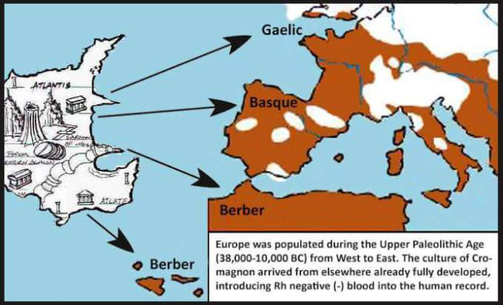 Sepehr's fantasy illustration showing Paleolithic Europe being populated form Atlantis. Sepehr's fantasy illustration showing Paleolithic Europe being populated form Atlantis. Sepehr challenges the idea that modern humans migrated into Europe from the east, stating “Cro-Magnon’s geographical distribution in Europe lies closer to the western part of Europe and North Africa, especially and probably most interestingly on a number of nearby Atlantic islands” (page 36). Also on page 44 Sepehr states that there were four stages of Cro-Magnon peoples appearing in northern Africa, including the Canary Islands, and fanning out from that western location. His ultimate claim is that the “evidence” of west to east movement supports the origin of modern humans in Atlantis. There are several problems with this. First, Aurigancian rather clearly moves into Europe from the east. This 2006 article by Paul Mellars (page 169) presents a map showing the spread of Aurignacian technology into Europe from east to west. Second, it is not clear that so-called Cro-Magnon peoples were the ones making Aurignacian tools. According to this article, Cro-Magnon
“doesn’t refer to a particular taxonomy or even a particular group located in a particular place. Cro-Magnon is a term that is commonly used to illustrate early modern humans who lived during the Upper Paleolithic Era. Simply, the word is not precise enough, and so most paleontologists prefer to use Anatomically Modern or Early Modern Humans.” While it is true that the Aurignacian tools are different from those of preceding periods and are usually thought to be the work of modern humans, there are very few skeletal remains associated with the Aurignacian. Mellars (page 177) explains that “Although finds of human skeletal remains in direct association with Aurignacian technologies are notoriously scarce in all parts of Europe, the available finds are entirely consistent with the conclusion that these industries were similarly associated with characteristically modern populations.” Mellars (page 177) notes that the “best association between Aurignacian industries and human remains are those of at least five individuals from the Mladeč caves in the Czech Republic.” Neanderthals would have been inhabiting Europe when human populations with Aurignacian technology came in. Since there are few human remains dating to this time period it is difficult to state for certain what truly happened when Neanderthals and modern humans interacted. As John Hoffecker writes “Because of the gaps and ambiguities of the human fossil record for this period, the transition from Neanderthals to modern humans in Europe has been reconstructed primarily on the basis of archaeological remains.” It is known that Neanderthals and modern humans lived in Europe during the same time for a number of years. It is logical to think that since Neanderthals had their own culture and own tools that Homo sapiens probably adopted some of the culture and tools which then they constructed to benefit them and their environment considering the latest Neanderthal remains have been found in western Europe, not eastern Europe. Additionally, I would like to point out that “archaeologists who specialize in the study of stone tools attribute particular types of tools, grouped into ‘industries’ or ‘cultures,’ with particular species of hominin.” This same article states that the stone stones found in France were called Aurignacian because the tools were found in Aurinac, France. How could modern humans have migrated from west to east, displacing or wiping out Neanderthals on the way, when the youngest Neanderthal remains are found in France? How can that logically happen? Wouldn’t that mean the youngest remains should be found in eastern Europe? Also, how can the Aurignacian tool industry “come from nowhere” when the archaeological site where these tools were found is in Aurinac, France? They look "new" in France because they came from outside of France, but from the east, not the west. Sepehr's claims that the modern human Paleolithic populations of Europe originated in Atlantis are not supported by evidence. Sepher quotes anthropologist Richard C. Leonard numerous times throughout the book and uses his “evidence and claims” to back up his argument on Cro-Magnon (e.g., on page 35). Sepehr also relies heavily on work from the early 1900's to support his claims. With science constantly evolving it is usually best to use research that is the most recent to show the newest findings. We know far more about humans and evolution now than we did back during the early 1900's. I would like to end this post with a quote by William R. Fix who wrote The Bone Peddlers: "The fossil record pertaining to man is still so sparsely known that those who insist on positive declarations can do nothing more than jump from one hazardous surmise to another and hope that the next dramatic discovery does not make them utter fools ..... Clearly, some people refuse to learn from this. As we have seen, there are numerous scientists and popularizers today who have the temerity to tell us that there is 'no doubt' how man originated. If only they had the evidence..." That is something to think about when reading his book. What exactly is the human fossil record? The Smithsonian defines it as the history of human species documented by fossils. It helps us to understand our sexual dimorphism, biological changes, when we began walking upright, and when we spread out across the world. However, the fossil record is not complete, is constantly being added to, and can be easily misunderstood. In Species with Amnesia: Our Forgotten History, Robert Sepehr tries to discredit human evolution by questioning the fossil record, arguing, among other things, that the “man-from-monkey” model is inaccurate and that Lucy has been badly misinterpreted. To Sepehr, the entire evolutionary paradigm is wrong: it has to be for his argument to work. He believes humanity to be a "hybrid species" that does not share a common ancestry in Africa and claims that there has been no unfalsified evidence to back up the man-from-monkey idea because followers of Darwin’s theory are passionately promoting this paradigm. Sepehr begins by attempting to discredit the fossil record by discussing Piltdown Man and other flaws of scientific investigation. In 1889, Charles Dawson and Smith Woodward found a set of teeth, a jawbone, and small skull fragments that supposedly belonged to the same individual. They interpreted this as the “missing link” because of both, ape-like and human-like features. Piltdown Man turned out to be a fraud. In the 1950's, tests showed that the skull and jaw fragments were actually from two different species, human and probably orangutan. In 1922, Nebraska Man came to be by Harold Cook who found a human-like tooth in the Pliocene deposits of Nebraska and called it the “missing link”. Apparently, Nebraska Man was even used as evolutionary evidence in The State of Tennessee vs. John Thomas Scopes in 1925. After the trial the entire skeleton was found and it actually belonged to an extinct species of boar. Sepehr also discusses other scientific “mess-ups”, such as the Southwest Colorado Man and the Montana Man. Sepehr (page 8) states that “There is a lesson here concerning the reliability of so-called expert testimony, which is so often produced simply to manipulate and intimidate the layman who lacks the proper mainstream indoctrination." The scientists acknowledged their mistakes and corrected their errors by running necessary tests when they became available. That’s how science works! What would science be if others did not come around to try to falsify claims? Piltdown Man and Nebraska Man are perfect examples of claims being falsifiable. As science advances, discoveries will be made and interpretations will change. And then he picks on Lucy. "Lucy” is a 3.2 million-year-old australopithecine fossil found by Donald Johanson and Tom Gray in 1974. Sepehr misinterprets “Lucy,” an almost full skeleton found at the site of Hadar in Ethiopia. There are several traits that identify Lucy as bipedal: the distal femur and angled knee joint surfaces; her human-like pelvis configured to balance the trunk on only one limb with each stride; a convergent big toe; and spinal lumbar curvature. Lucy is presumed to be a female because of the clear differences in sexual dimorphism of that time period. 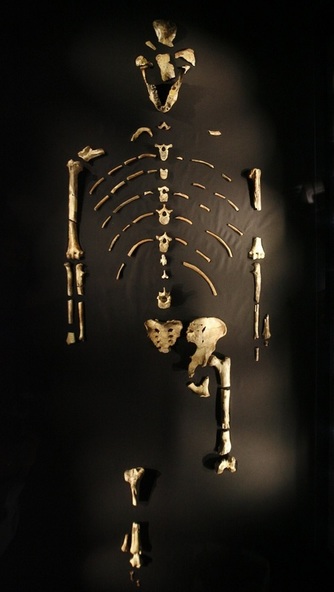 Lucy’s Skeleton https://fossilhistory.wordpress.com/tag/lucy/ Lucy’s Skeleton https://fossilhistory.wordpress.com/tag/lucy/ Sepehr claims that the conception of Lucy being sold to the public differs from the fossil evidence. The reconstructions of her in museums all show her with human eyes, human-like hands, bipedal, and with human-like feet. He shares “evidence” from studies and scientific journals, arguing against Lucy’s bipedalism: she has grasping foot tendencies, does not have a locking mechanism in her knees which allows us to stand for long periods of time; she has the morphology of a knuckle-walker. He appeals to creationist websites for support in kicking Lucy out of the family tree. Sepehr seems to not want to understand the evidence and ask why Lucy might have some some ape-like and some human-like features. According to a Live Science article, Lucy was discovered to have upward facing shoulder blades, unlike humans’ downward shoulder blades, suggesting she was still spending some of lifespan still in trees. She still has a human-like hip bone, lower limb, and foot that shows upright walking adaptation. Sepehr does not seem to understand the fact that Lucy has been determined ape-like and human-like combined. She is not the common ancestor or the “missing link” but another starting point to the history of our human evolution, an observed partial common descent. Sepehr seizes on the recent (2015) news that a piece of the thoracic vertebrae found with Lucy was actually part of a baboon. The bone was found during work for a new Lucy reconstruction. Scott Williams, one of the researchers involved, confirmed that " . . . the other 88 fossil fragments belonging to Lucy’s skeleton are correctly identified. And the mislabelled baboon bone fragment doesn’t undermine Lucy’s important position in the evolution of our lineage." Sepehr concludes his attempt to discredit evolution with a misinterpretation of a statement about Ardipithecus by well-known biological anthropologist Dr. Owen Lovejoy. Lovejoy states, “people often think we evolved from ancestors that look like apes, but no apes evolved from ancestors that look like us” (page 14). Sepehr twists Lovejoy’s words by saying that Lovejoy means “man didn’t descend from apes” and “our knuckle-dragging cousins descended from us” (page 15). Lovejoy actually meant that the common ancestor of chimpanzees and humans did not look exactly like either, but had many features that were retained in the hominin lineage.  In Species with Amnesia, Robert Sepehr attempts to show that blue-eyed people were present prehistorically outside of Europe. Sepehr tries to prove this to support his claim that blue-eyed people came from Atlantis and spread throughout the world. Included in his examples of blue-eyed people outside of Europe are the Guanche people of the Canary Islands (page 98), the Chachapoya (page 98) also known as the “cloud people,” the legends of "white gods" (page 101) and, finally the Lady of the Mask (page 102) which he says is a mummy with blue eyes. The Guanche The Guanche were a group of people who lived on the Canary Islands, an Atlantic island which is now a part of Spain, around the 15th century. While it is unknown for sure how the Guanches arrived on the islands there are many artifacts and mummies. The Guanches buried their poor in the sand and mummified their upper class in caves; their mummies were discovered in 1933. I have been able to find some sources that say they had blond hair but it has been proven that mummified body’s hair turns blond or red over time, because of decomposition of hair pheomelanin. Sepehr shows two pictures of Guanche mummies (Figures 42 and 43). I found no credible websites that could support Sepehr’s claim that the Gunache mummies had blue eyes. The Chachapoya Sepher claims the Chachapoya, a south American people also known as the “cloud people,” were a light-skinned, blue-eyed people. They lived in the ninth century high up in the Andes mountains in present day Peru. Archaeologists have found, unlike other people living in the area, the Chachapoya were much more advanced with their building methods, daily utensils, technology and mummified there dead and put them in caves. There is little written text left about the Chachapoya because of the conquest of the Incas by Spanish conquistadors in 1512. n researching these people, I found a single account that says, “One controversial explorer named Gene Savoy claimed that the Chachapoya had light hair and blue eyes.” This account would be great support for Sepehr’s claim that the Chachapoya were a strong advanced people with light skin and blue eyes, but there apparently is no evidence for this beyond one explorer’s claim. There is no real evidence to prove they had blue eyes and DNA tests can show these people came from natives in the area not blued white skinned people from Atlantis: "An analysis of the mummy skeletons using testing of DNA samples has shown that these people were probably related to other Native Americans of that region, they were definitely a very distinct culture.” (source). "White Gods" Another thing Sepehr uses to help advance his claim of blue-eyed people is the belief that ancient cultures around the world were visited by Caucasian races in ancient times, and that they were known as "white gods." Some examples used in Sepehr’s book were the Inca’s refrence to a white god called Viracocha and the Aztec’s “white god” Quetzalcoatl. He is said by some cultures to be the god of everything or the god that created a city called Tiahuanaco. But there is no real evidence of this god. A 16th-century account of the Spanish conquistadors being "greeted as gods" by the Incas because their lighter skin resembled the god Viracocha has now been used by certain authors to extend this concept beyond what is historically verifiable, allowing it to spread to the genre of pseudo archaeological literature and fringe theorists, and white supremacist connotations. The Lady of the Mask The last example that Sepehr uses is the Lady of the Mask. Sepehr claims that a blue-eyed elite people called the Moche ruled the northern cost of Peru before the Inca existed. He supports this claim with what he calls a “blue eyed mummy”. But after researching the Lady of the Mask I found out that there was a mummy found in Lima Peru that came from the Moche people, the mummy that was found had a mask over its face and the eyes on the mask were painted blue which is said to be symbolic, not literal. Sepehr’s claim that the Moche had blue eyes is based simply on a painted mask! (And Sepehr's description of the mummy is copied directly from the Daily Mail article with no attribution). There is no archaeological/DNA evidence that says the Moche people actually had blue eyes. In conclusion, there is no credible evidence to support any of Sepehrs claims that the Guanche, the cloud people, Quetzalcoatl (white god) and the Lady of the Mask were blue-eyed people who lived outside of Europe before the time of European exploration. This is detrimental to Sepehr’s claim that some indigenous non-Europeans had blue eyes, which is closely connected to his thesis that white, blue-eyed, blond-haired, swastika-wielding people were a "master race" that originated in Atlantis and spread out through the world. It is important for Sepehr to push the idea of global Aryan presence for his claim because Sepehr thinks white people in Atlantis were supposed to be intelligent and superior to other races. Species with Amnesia is a profoundly racist publication that is based on profoundly thin "evidence." In his book Species with Amnesia, Robert Sepehr abuses science to manufacture support for his argument that the "races" of humanity are actually separate species. Specifically, Sepehr argues for the distinction of the white race, stating his interest in “Europeans, which were originally a separate species from African lineages” ( page 34). He cites scientific research suggesting that white people are the most genetically similar to “anatomically correct” humans like Cro-Magnons, while people of color share genes with “archaic hominins” (page 25). The implication of this theory is that white people descend from true, modern humans and everyone else is a mixture of primitive human-like species and are therefore lesser beings; this idea places Caucasian people at the pinnacle of intellectual and physiological advancement, and suggests that Aryans are biologically superior. 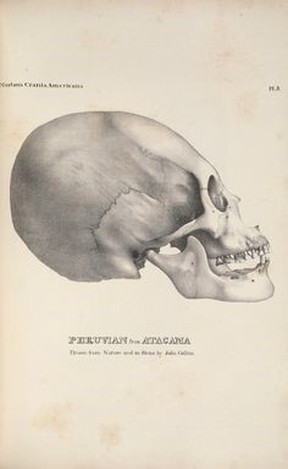 Image of a Peruvian skull from "Crania Americana." Image of a Peruvian skull from "Crania Americana." Unfortunately, the manipulation of science to support racist agendas is not a new phenomenon. Scientific racism has been used for centuries to justify acts such as the enslavement of Africans and the disenfranchisement of American Indians. In 1839, a man named George Morton published a book of illustrations called Crania Americana, which depicted an array of different skulls that he claimed demonstrated the physiological differences between races. In this publication, Morton proposed that differences in skull structure were indicative of differences in mental capability, where the shapes and sizes of white people’s skulls reflected the greatest intelligence. These claims gave scientific credence to racist ideas of the supremacy of the white race and informed Euro-American perspectives on "race" for decades. While the claim that non-white races were more primitive and even non-human used to be based on crude "scientific" data such as phrenology and other physical measurements, modern day racists now utilize genetics to highlight differences between races. Sepehr describes himself as a paleobiologist or archeogeneticist, terms that suggest his use of genetic data is expert and legitimate. Sepehr’s claim that white genes are modern while the genes of other races are archaic and of separate species is unsupported by real scientific data. In his book, Sepehr cites scientific research that shows people today have DNA with genes shared by now-extinct human groups such as Neanderthals and Denisovans. Sepehr interprets this information to mean that separate species were capable of interbreeding, and because different races share variable amounts of Neanderthal and Denisovan DNA, that different races are the products of different species intermixing. Sepehr cites a 2013 paper in Genetics by Jeff Wall et. al that shows higher levels of Neanderthal DNA in East Asians than Europeans; he uses the ideas presented in this article to support his claim that archaic genes are more prevalent in non-white races, but neglects to include the fact that people of recent African decent have little or no Neanderthal DNA, which by his own sloppy argument would suggest that they are more fully modern humans. A large part of Sepehr’s presumption that races are different species relies on the existence of different and incompatible blood types. In chapter two of Species with Amenesia, he asserts, “if mankind evolved from the same African ancestors, their blood would be compatible, but it is not” (page 23). The basic assumption of such a statement, however, is wrong: scientists have discerned that blood types most likely evolved in reaction to the diseases that specific human populations were exposed to. The fact that certain blood types are incompatible is “an accident of evolution” that has not been accounted for through natural selection because “blood transfusion is a recent phenomenon, and therefore has nothing to do with the evolution of blood groups.” In other words, blood transfusions don’t occur in nature, so why would it matter if one person’s blood can’t be injected successfully into someone else? Apparently Sepehr hasn’t considered this, or maybe he thinks highly advanced Aryan Atlanteans were capable of performing blood transfusions during the Ice Age. Like many fringe theorists, Sepehr is fixated on Rh-negative blood. He discusses that Rh-negative blood is more common in Aryan individuals, and that if a woman is pregnant with a baby that has the opposite Rh blood type to her, the pregnancy can be terminated by the woman’s own immune system. Sepehr suggests that this would only happen if individuals of different races/species were not meant to interbreed. However, Rh Sensitivity is a rare occurrence and is a consequence resulting from random mutations in genes that affect blood rather than the result of unsuccessful interspecies mating. Furthermore, while certain blood types are more common to certain races, blood type and race do not perfectly correlate; the O blood type occurs more in people of recent African descent, but I myself, a white individual, have O+ blood, as do both of my white parents. Sepehr’s argument of interspecific mixing is also flawed by basic scientific illiteracy. A cornerstone of his argument is the idea of species and speciation, but it appears that he has a fundamental misunderstanding of what a species is. According to the biological species concept, species are defined as “related individuals that resemble one another, are able to breed among themselves, but are not able to breed with members of another species.” This is very important. The basis of distinguishing one species from another is their ability to interbreed; therefore, if two individuals can breed and produce viable offspring, THEY ARE NOT SEPARATE SPECIES! In an attempt to circumvent the biological species concept, Sepehr includes various examples from the animal kingdom that demonstrate how “two separate and distinct species…can produce viable hybrid offspring” (page 25). However, Sepehr’s examples simply do not prove what he thinks they do. Some of these examples are outdated or incorrect, such as the idea that domestic dogs and gray wolves, which can interbreed, are separate species; scientists have considered dogs and wolves the same species since 1993. Sepehr mentions, but glosses over, the caveat that most offspring produced by interspecific mating, such as the blood parrotfish and the Yakow, are infertile. By the biological species concept, infertile offspring are indicative of an unsuccessful mating, which reinforces the idea that mated species cannot interbreed. Sepehr also includes certain examples, such as the Grolar bear, which biologists acknowledge as the result of interfertility but still consider separate species due to the geographic and adaptive separation of the parent species. While grizzly and polar bears are theoretically interfertile (capable of interbreeding), they do not successfully interbreed in nature due to the great distance the two species live apart and the fact that hybrid offspring would likely die in the habitat of either parent species due to maladaptation. In other words, though organisms could reproduce if they came into contact or were artificially inseminated, nature does not “allow” them to mate, so they function as separate species. It is notable that humans do not exhibit any of the pitfalls of interspecies mating: we produce offspring that can reproduce themselves, and, due to human propensity for global travel, can interbreed with people from different environments, where we can and do live successfully. While the field of paleoanthropology is often limited in its classification of species because fossils cannot breed, genetic evidence of interbreeding such as that presented by Sepehr himself would indicate that people of different races as well as certain “archaic” human types with which they share genes are and were capable of interbreeding and therefore are not separate species. The definition and scientific idea of a species renders Sepehr’s whole argument completely invalid. How embarrassing. Recent genetic studies have shown that human genetic variation is a result of geography and not speciation. The differences between races are no more significant than the natural variation between individuals of the same race; phenotypic variety among humans evolved as a result of the geography in which we each lived and does not exist because we are distinct species. Species with Amnesia is a fundamentally racist publication, in which Robert Sepehr strives to assert the dominance of the Aryan race over the rest of the world on both a cultural and genetic basis. The book’s arguments are not founded in real science. The idea that people of different races all belong to the same species, which Sepehr has deemed mere “political correctness,” has been proven by modern science to be fact. So if Sepehr believes he, as a white man, is a “modern” human, perhaps he should abandon such archaic views. The development of agriculture was arguably one of the most important things that happened in recent prehistory. The ability to feed large populations in a compact area allowed the global human population to explode from the thousands to the billions in a relatively short period of time. For this reason, modern science knows a good bit about the emergence of agriculture: archaeological data show that the establishment of larger, more complex civilizations was associated with evidence of intentional food production and manipulation. It is relatively straightforward science and easy to recognize once you know what you’re looking for. The majority of mainstream academics and archaeologists agrees that small-scale farming first arose between 10,000 and 15,000 years ago. Agriculture arose independently in several different areas of the world at different times. Robert Sepehr however, disagrees. In his book Species With Amnesia, Sepehr details his belief that the myth of Atlantis was a factual historical account of an ancient advanced civilization. Throughout the book he presents evidence that he claims has been suppressed. One pillar of his argument for an advanced civilization during the Ice Age is that Cro-Magnon peoples practiced agriculture. Sepehr (page 49) states that “a number of sites, dating back as far as 16,000 B.C, evidence the practice of agriculture. . . . Professional anthropologists realize that without agriculture, Atlantis, or any other antediluvian civilization, is no more than a myth.” We know that Plato provided the first written account of Atlantis around 360 BCE. At the time that he wrote, he claimed Atlantis was at least 9,000 years old. This would imply then that because agriculture is vital to the support of a large sedentary civilization, full-scale agricultural techniques would have to have been in practice a minimum of 11,400 years ago. Sepehr’s phrasing of his assertion for agriclture at 16,000 BC is key as it is tactfully non-specific. “A number of sites” implies a number substantial enough to support a claim. But Sepeher gives the reader no clue as to precisely how many. “Dating back as far as…” is not definitively wrong, as there are sites with evidence of domestication dating back millennia. He does, however, seem to be stretching the truth: the origins of agriculture are well studied and documented and there is no reason to believe that it was a common practice 6,000 years before the generally accepted timeline. Sepehr doesn’t provide information to reference his claim of multiple significant sites so the reader is left to trust his personal opinion. If Sepehr's claim were true, it would be exciting news for the archaeological community, so it is also unclear why he then implies archaeologists are rejecting evidence that supports this dating. It is the opposite of the scientific attitude to reject viable evidence simply because it does not fit within the parameters of your current hypothesis. Yet this is the implication embedded within Sepehr’s book, in this section and in many others. Species With Amnesia seems to be written with the intent of seeding mainstream doubt for the academic community. As Sepehr notes, without agriculture there is no Atlantis. So if his story about the Cro-Magnon is true, there should be evidence of agriculture associated with those populations all during the Ice Age. But there's not. It is apparent that what Robert Sepehr wishes to find and what he has actually confirmed are two different things, but that is perhaps why he does not go into detail. Robert Sepehr is a vocal supporter of hyperdiffusionism and this book is an integral part of the career he is trying to build around this theory. His belief that all advanced civilizations come from a single traceable ancestral line of Atlanteans simply does not have any proven scientific evidence. He does however attempt to prop up his theories using his speculation about Cro-Magnon invasions along the British Isles and Europe. Sepehr’s narrative outlines a story of refugees from an unstable land off the coast of northern Europe. These refugees he believes, evacuated regularly on a cycle of environmental destruction every few thousand years until one final natural disaster caused total collapse. Sepehr then connects his tale to the more ancient one of the 9,000 BCE demise of Atlantis. Supporting evidence here is lacking but this is where Sepehr’s assertions of a more ancient agriculture trend come into play. Robert Sepehr’s claims are problematic, and the underlying implications of those claims are worth examining. His “alternative diffusionist arguments” tend to focus on his concepts of race and add a tone of reverence for the glorious past he believes only some humans share. When reading Sepehr’s claims within his book it becomes apparent that he is willing to stretch legitimate scientific claims in order to fit it to his greater framework of an Ice Age advanced civilization. His claims that agriculture was widely practiced before the commonly accepted Holocene dating is nonsense. There is no accepted evidence to date that supports widespread agriculture during the Ice Age. Species With Amnesia by Robert Sepehr is about highly advanced civilizations, such as Atlantis, that were destroyed by a global catastrophic event. On page 1, Sepher writes “But for each race that has died out, another has taken its place, with a selected few holding on to the memories and sacred knowledge of the past race.” The author suggests that the Cro-Magnon men were remnants of the original civilization and had advanced knowledge. He believes that the Cro-Magnon cave art verifies that they were an advanced race because it shows an understanding of astronomy. The Cro-Magnon were early Homo sapiens that lived in Europe during the Upper Paleolithic period. They were first discovered in a cave in Southwestern France in 1868. Many have speculated that the Cro-Magnon had a sophisticated culture because of the tools and cave art they produced. Cro-Magnon cave paintings have been found at sites such as Lascaux, Eyzies-de-Tayac, and Altamira. The Grotte de Lascaux site is filled with pictures of animals including a deer with a row of thirteen dots and a square below it. Sepehr cites Lascaux, the Magdalenians View of the Sky, by Chantal Jegues-Wolkiewiez, to support his claim that the Cro-Magnon men possessed divine knowledge. According to Wolkiewiez, the deer with the dots below it shows the lunar cycle. In another part of the cave there is a brown horse with 29 dots under it. She says these dots represent days of the month. These two examples from Lascaux seem to be pretty basic for the supposedly advanced people that Sepehr claims the Cro-Magnon were. All these two examples prove is that the Cro-Magnon people paid attention when the sun and moon rose and set, something that many people around the world have done for a very long time. These two cave paintings do not prove that the Cro-Magnon men came from an advanced precursor civilization.
Many others believe that Paleolithic people knew the patterns of the sun and moon. Cave art might very well show that the Cro-Magnon men looked at the night sky and painted it on the walls. Wolkiewiez and other researchers believe that the cave art might have been pictures of constellations. The Lascaux cave has a picture of a bull with six dots above it and four dots to the left of it. Researchers such as Wolkiewiez believe that the bull is Taurus, the dots to the left are part of Orion's Belt, and the dots above are the cluster of stars known as Pleiades. Bulls are a major part of the Lascaux cave and show that they were important to the Cro-Magnon people who lived in France during that time. The six dots above the bull could represent the Pleiades, but the constellation actually has seven stars. The dots to the left might be Orion's Belt, but the cluster is famous for only having three stars. The dot missing from the cluster above the bull could have faded during the course of 15,000 years, or the painting may not even represent Pleiades at all. It is difficult to explain the extra dot on Orion's Belt. The Lascaux was discovered in 1940 and it was said to be in perfect condition when it was first discovered. The cave was opened in 1948 and had around 100,000 annual visitors. Artificial lighting caused the colors of the walls to fade, and welcomed the growth of algae, bacteria, and crystals. The cave was closed to the public in 1963 and the growth of these organisms halted. In 2001, algae, bacteria, and crystals began to grow again. A great deal of the story may have been lost during this time period. In conclusion, Species With Amnesia attempts to prove that there was an original civilization and a master race that were god-like and had some sort of divine knowledge. Sepehr claims that the Cro-Magnon people were survivors of Atlantis because they had knowledge of astronomy. Sepehr writes "My personal take is that there is definitely astronomy on the walls of Lascaux" (page 40). Because the Lascaux cave is very old, it is difficult to say that the dots under the deer and horse represent the lunar cycle and the days of the month. Although there are some inconsistencies with the so called Taurus drawings on the wall, the theory seems to be possible. The Cro-Magnon cave art could simply represents animals they would have hunted and predators they would have feared. Even if researchers such as Wolkiewiez and Sepehr are right about astronomy being on the walls of the Lascaux, however, this does not mean that the Cro-Magnon men were an advanced and superior race. The truth is, there is still a lot to learn from the cave art. In Species with Amnesia, Robert Sepehr claims that the "Out-of-Africa" model of human evolution is wrong and that modern humans, represented by Cro-Magnon, really came from Atlantis. For this blog post we will be focusing on Sepehr's claims about the physical characteristics and genetics of these Cro-Magnon “Atlanteans”. According to Sepehr (pages 24-25) "modern Northern Europeans are most similar to Cro magnon’s : Tall, high Frequency of RH negative blood type , fair haired and blue-eyed.” 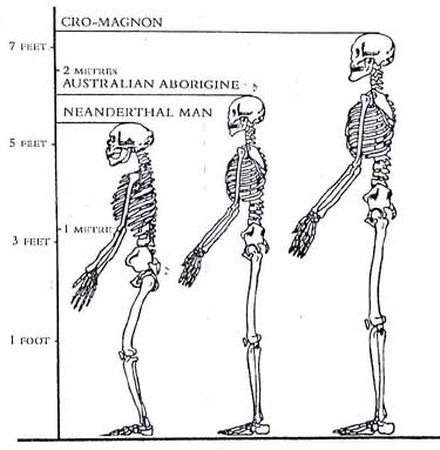 One of many incorrect figures found online showing Cro-Magnon people as being very tall. One of many incorrect figures found online showing Cro-Magnon people as being very tall. Tall One of Sepher's claims is that Cro-Magnon (now more commonly known as Early European Modern Human (EEMH)) had an average height “well over six feet" (page 51). The reason this is important is because then Cro-Magnon would have the closest similarity to Sepehr's imaginary Atlanteans. This claim is simply not true, at least not at the moment with the current evidence. I can find no reliable source that says that Cro-Magnon had an average of well over 6 feet tall. The closest thing to this claim I could find were that “Males were 5 feet 4 inches to 6 feet tall" ( Dennis O’Neal ). Also, another source (Mysteries of Life, Death and Beyond by Patrick Conte) says “their average height is considered to be about five foot, nine inches, but some may have stood six feet five inches or taller.” “May” is not the same as did or was. Someone cannot just say that just because something may have been true, that it is well supported. RH Negative Blood Another thing Sepehr claims in his book is that because there are RH+ and RH- people, and RH+ is commonly found in the Rhesus monkey, that humans must have interbred with other species and that people with RH- blood are the pure bred Atlanteans. He states (page 24): “Karl Landsteiner and Alexander s. Wiener discovered the RH blood factor. 85% of the human population has the RH D antigen on their red blood cells which was in common with rhesus monkey, while 15% of the population mysteriously do not have the antigen. The 1994-2002 edition of Encyclopedia Britannica says that the Sweden county Dalarna today is characterized by almost pure Cro-Magnon.” Unfortunately for him this has a simple explanation that does not involve Atlanteans: mutation! Mutation is an important part of evolution by natural selection. When an individual has a mutation that is beneficial, that individual can pass on its genes to the next generation. Researchers think that RH- blood makes people more resistant to certain kinds parasites. Perhaps there are evolutionary reasons why RH- blood occurs in high frequency in Sweden. So how do we know Cro-Magnon people were RH-? We don't. But in Sepher's view, since Swedes are "almost pure Cro-Magnon," and Cro-Magnon are the closest thing to pure blooded Atlanteans, people with RH– blood are pure blooded Atlanteans. Fair-Haired and Blue-Eyed Sepehr's argument about fair-haired and blue-eyed Cro-Magnon people follows much of the same pattern as his RH- argument. In fact, most of his arguments stem from the “fact” that Atlanteans (of which there is no evidence) are most like Cro-Magnon, who are most like modern northern Europeans. Scientist don’t know exactly why the genes for lighter skin, blue-eyes and fair hair appeared, but a recent genetic study suggests that white skin only evolved about 8000 years ago, well after the earliest "Cro-Magnon" skeletons. Conclusion Basically, Sepehr seems to be trying to say that the earliest "modern" humans in Europe where tall, blond, white people very similar to the northern Europeans of today. This fits overall with his argument of the superiority of "Atlanteans" and their descendants (i.e., white people). There is no evidence that Atlantis was anything more than a myth, yet it is important to Sepehr that the Atlanteans are are tall, fair haired and have blue eyes. He has created a fictional superior people that he says are very much like modern northern Europeans. He also has a very Nazi-like imperial eagle symbol on the back cover of the book. Overall, his concepts prove nothing about Cro-Magnons being related to Atlantis. To even take his arguments seriously you would first have to believe that Atlanteans were real, of course, which no one has proved . They are just puzzle pieces that he cut out himself to fit a narrative. |
AuthorWrite something about yourself. No need to be fancy, just an overview. ArchivesCategories |
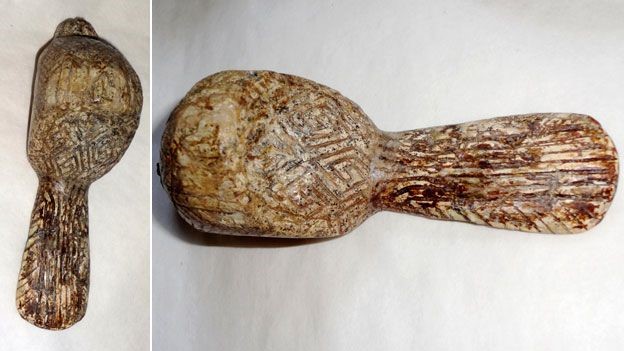
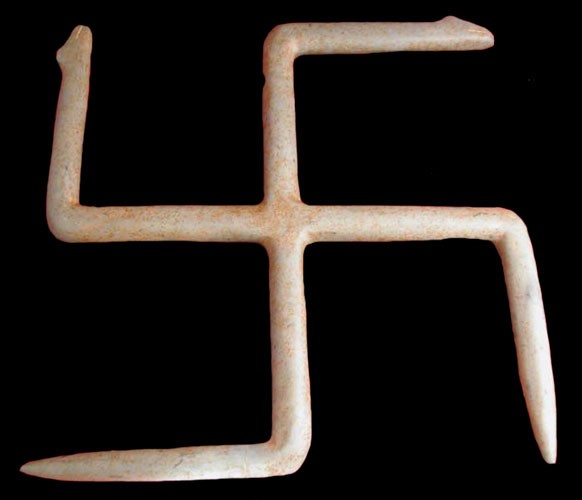

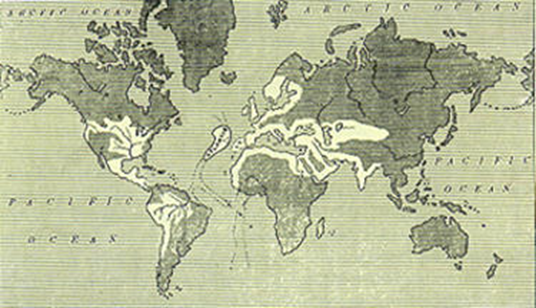
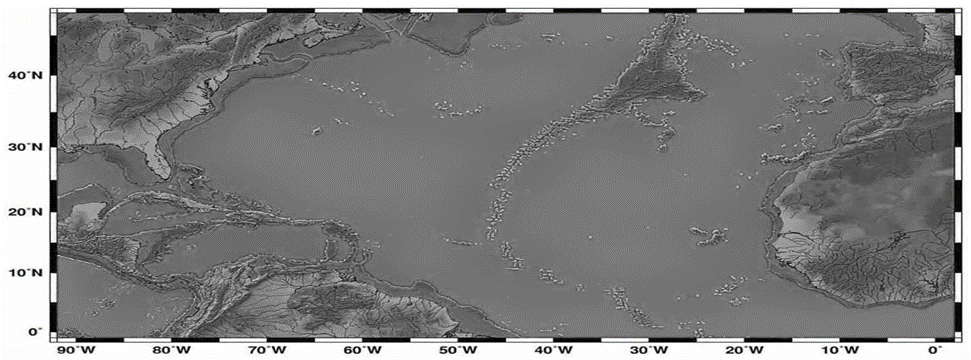
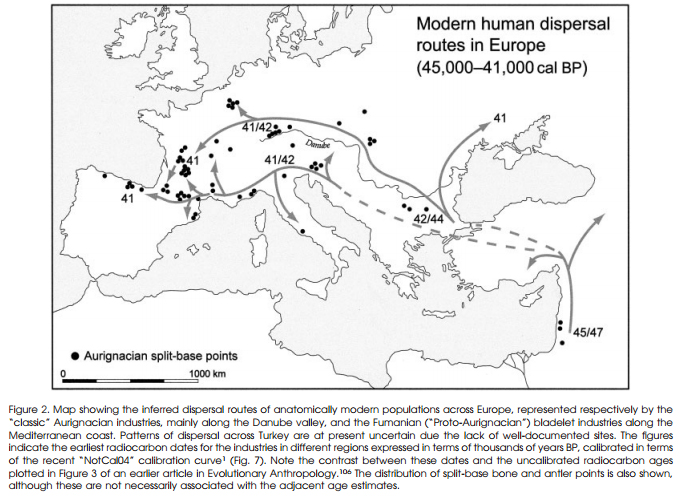
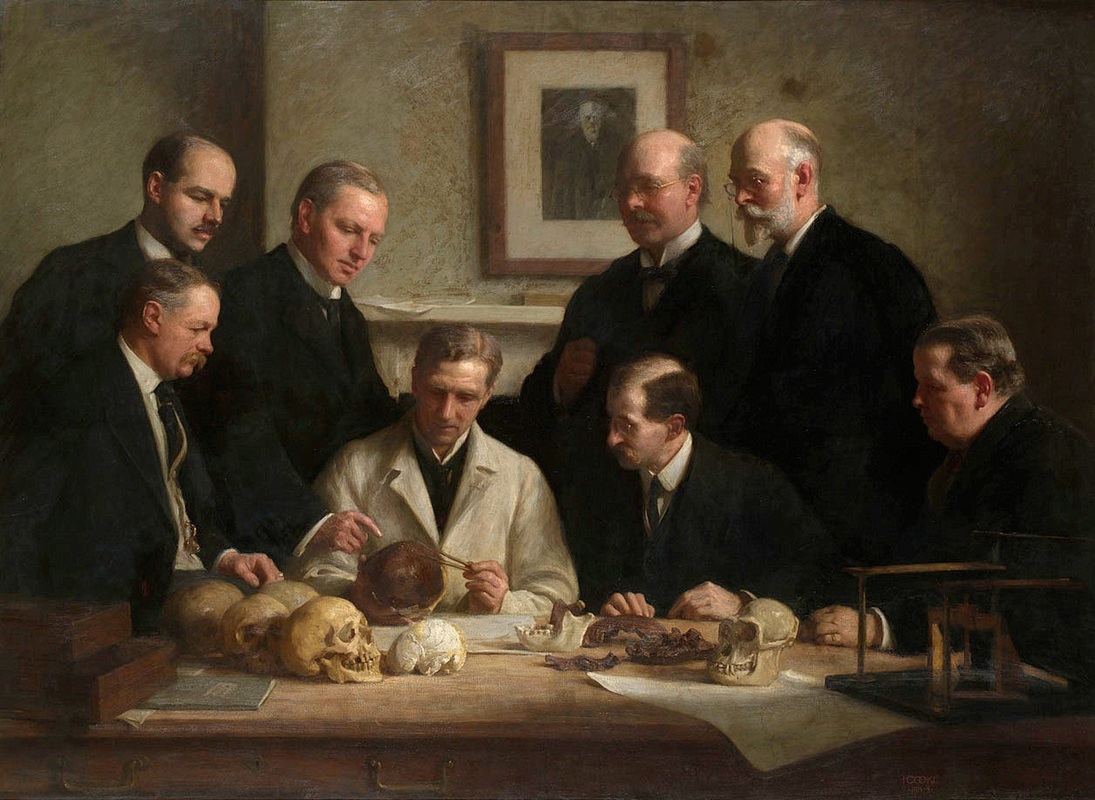
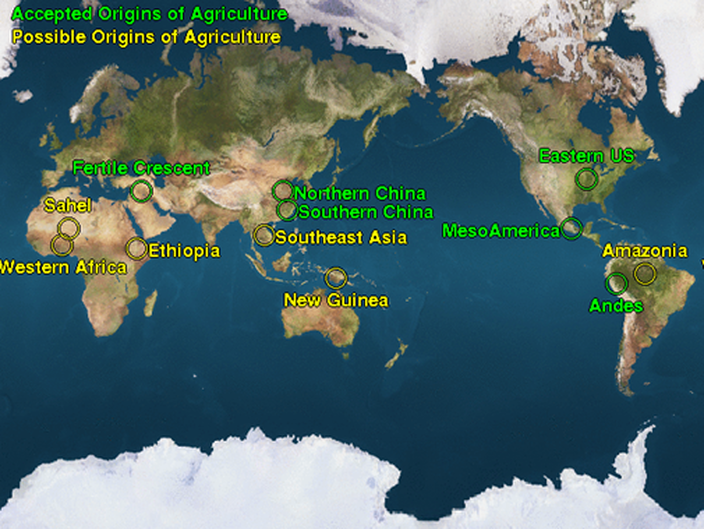
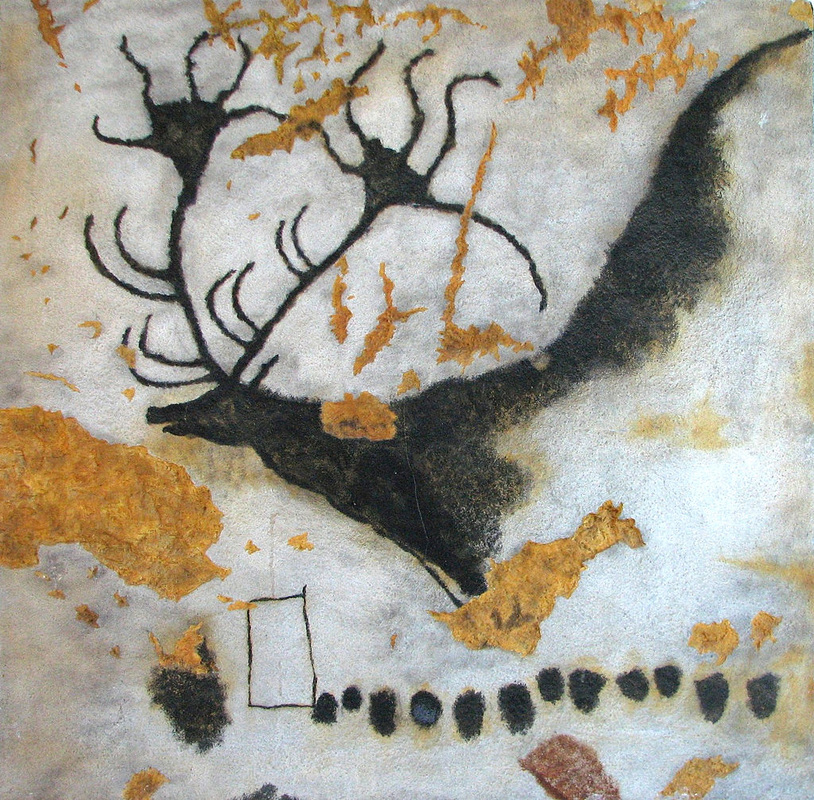
 RSS Feed
RSS Feed
